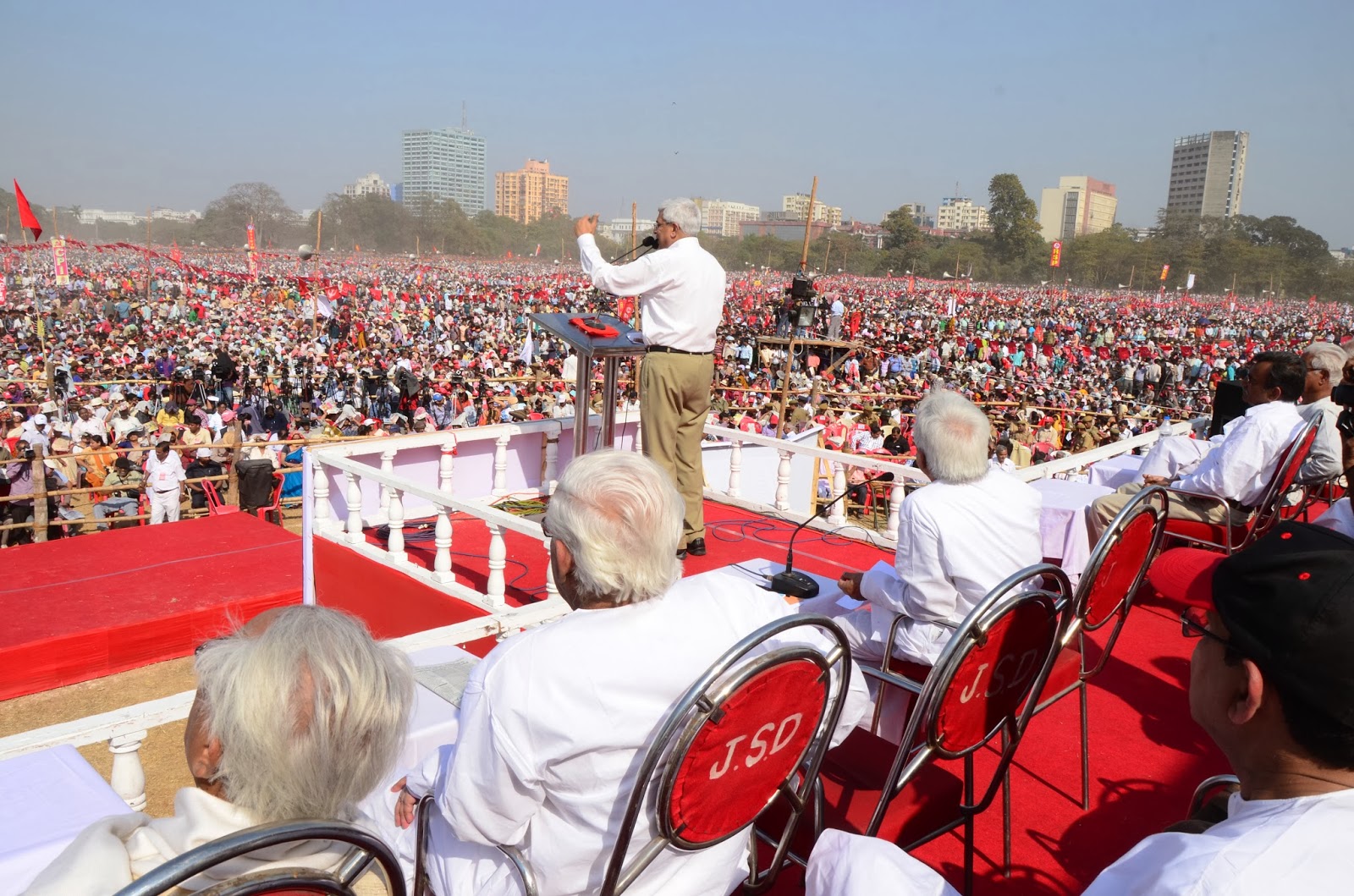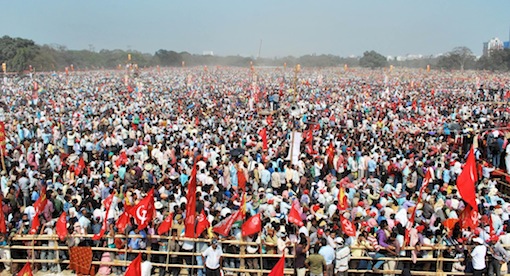Left
Challenges Authoritarianism
By Debasish
Chakraborty
AS the
Brigade Parade Ground in Kolkata turned into a sea of humanity, splashed with
crimson red all over, roaring slogans reverberated in every street leading to
the ground, even the Ganges became red with streams of boats carrying hundreds
of people, the question emerged, how this ‘miracle’ was made possible.
Even the
staunch anti-Left media was forced to admit that the Left Front rally on 9th
February not only surpassed in its size and spirit the two earlier rallies in
the same ground in the last ten days but also was the largest the city had seen
in at least two decades. This has happened despite terrorisation, life-threats,
obstacles created by the ruling party in every step. This was not a usual
rally; it was the defiance of an authoritarian regime, an outburst of anger, a
collective determination to break through darkness. Spring has just started to
bloom in flora and fauna of Bengal, the rally was a festival of courage.
It was not
‘miracle’, it simply proved, once again, how deep the roots of the Left are in
the society of Bengal.
Many came
from terror-stricken areas in unique ways, escaping the vulture eyes of the
goons of the ruling party. Some, from East and West Medinipore districts
started a day earlier, individually and then met somewhere to march to Brigade.
From Bengal-Jharkhand border areas, the people came without any external sign
that they were moving towards Kolkata. On the day of the rally, buses carrying
people were forcibly stopped in many areas in Burdwan. The people either chased
the hoodlums or just shifted their journey through trains to finally reach the
rally ground. Stories of distinctive methods and bravery were abundant. These
struggling people gathered more confidence, more courage to fight back the evil
forces that have gripped not only the political power but also the
socio-cultural fabric of Bengal.
On 30th
January, Trinamool Congress held the rally at the same venue where Mamata
Banerjee avoided all important issues of the state and gave a call of “Delhi
Chalo”, without any clarity with whom she wanted to go with. Five days later,
Narendra Modi held his first public meeting in the same place and proposed the
formulation of “Mamata in Bengal, Modi in Delhi”. The political message was not
that secret: tacit understanding between BJP and TMC was in the offing. On 9th
February, Left Front leaders clearly gave a call of a government at the centre
which would be based on alternative policies.
CPI(M)
general secretary Prakash Karat strongly criticised the UPA-2 government which
came to power in 2009 with Mamata Banerjee’s help as one which has only
multiplied the woes of the common man; rampaging inflation, growing
unemployment, massive corruption. The BJP, which was trying to pose itself as
an alternative, had the same economic policies. Modi’s Gujarat model, he said,
was but a euphemism for large scale ‘loot’ by big corporations, Indian and MNC.
Modi stands for ensuring supernormal profits for these companies and will
complete the full measure of neo-liberal economic policy. That apart, Karat
reminded the people of BJP’s communal agenda and Modi’s active role in the 2002
genocide. The party is therefore working towards creating a non-Cong and
non-BJP alternative that will govern the country on an ‘alternative policy’
trajectory. He informed the people of Bengal of the initiative taken by the
CPI(M) and the Left parties to bring together non-Congress, non-B J P secular
parties. He announced that these parties will meet soon and announce the
political programme before the Lok Sabha elections.
CPI(M)
Polit Bureau member Buddhadeb Bhattacharjee said that the Mamata government was
insulting the youth of the state, not only increasing unemployment by virtual
shut down of industrial development, but being dishonest in advertising
creation of new jobs, a trickle actually, like the contractual policemen, which
paid less than minimum wage or exhorting them to work for fraudulent companies
such as Sharada etc. He accused her of
playing with the lives of the Bengali people. He said all work, be it industry
or agricultural had come to a standstill. He termed the government as
shameless; wasting people’s money for promoting her own face in government
sponsored advertisements at an unprecedented scale, every possible media
vehicle, every day. He blasted the CM for having a tacit understanding with the
communal BJP and exposed Modi’s governance claims. He reminded the people that
Gujarat, unlike Bengal, had no record of land reforms and no people’s
representation at the grassroots level. It was backward in mass education. He
said that the people of Bengal would never accept ‘two laddoos of Modi-Mamata
coalition’ that BJP PM hopefully offered.
Left Front
chairman and CPI(M) Polit Bureau member, Biman Bose, reminded the gathering of
the promises made by the TMC before the 2009 Loksabha polls and 2011 assembly
polls, which were now proved as hollow. All that the CM was interested in was
hosting ‘festivals’ at the cost of keeping crores of stomachs hungry. The
government and the ruling party were encouraging the growth of anarchy and
divisive forces. It was trying to break the unity of the poor and toiling
masses, every dissenting voice is being muffled. He urged the people of Bengal
to recognise the true face of this ‘dishonest’ political force, which has taken
145 lives of Left workers and leaders so far. She had allowed her ‘naughty’
boys to attack women savagely, with the most heinous cases of rape and murder
becoming common place in the state. It was a shame for all Bengalis that the
most modern, cultured and safe society of Bengal is now a leader in the country
today in atrocities against women. Basu called for resistance to terror with
courage.
The leader
of the opposition and CPI(M) Polit Bureau member, Surjyakanta Mishra,
electrified the gathering with his warning to the CM to use her ‘eyes &
ears’ to listen to the protests of the people of Bengal. He castigated her for
the complete lack of democracy in her party, her voice being the only one. As
he delivered the charge sheet against the TMC government, the massive crowd
roared in approval. He dubbed the government as totalitarian, anti-people,
anti-development and corrupt. He exposed the massive growth of per capita debt
of Bengal after this party came to power. Rs 55,000 crore had been added in just
30 months. Bengal had gone from being the 13th in per capita debt to being the
No.1 in the country. He charged that the CM had bankrupted the state by her ad
hoc expenses, most of it on festivals across the state, throughout the year.
The new administrative calendar was more of a festival itinerary, having
planned 60 in the coming year, one a week. He thundered that the people would
no longer allow her to loot the votes like she had done during the panchayat
and municipal polls, they would fight back.
Other
speakers at the rally included Hafiz Alam Sairani of Forward Bloc, Kshiti
Goswami of RSP, Manjukumar Majumdar of CPI, Ratan Mazumdar of DSP, Janmejaya
Ojha of SP, Mihir Bain of RCPI, Pratim Chatterjee of MFB, Umesh Choudhury of
BBC, Shivnath Sinha of Workers party, Samar Bardhan of Bolshevik party.
The mammoth
rally roared in one voice as Buddhadeb Bhattacharjee said, ‘the voices of the
toiling masses of Bengal cannot be stopped; the Red Flag can never be forced to
surrender’.
https://plus.google.com/u/0/photos/107460306998502333712/albums/5978744569589924913
https://plus.google.com/u/0/photos/107460306998502333712/albums/5978744569589924913




















